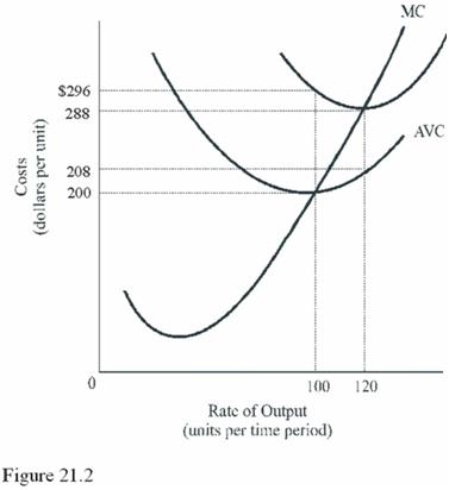A) Opportunity cost of the output.
B) Average productivity.
C) Marginal physical product.
D) Marginal cost.
Correct Answer

verified
Correct Answer
verified
Multiple Choice
Which of the following is a factor of production for the Little Biscuit Bread Company?
A) Flour.
B) Bread.
C) Productivity.
D) Money.
Correct Answer

verified
Correct Answer
verified
Multiple Choice
At 20 units of output in Table 21.2, the average variable cost is
A) $1.10 per unit.
B) $1.75 per unit.
C) $2.00 per unit.
D) $3.10 per unit.
Correct Answer

verified
Correct Answer
verified
Multiple Choice
If a firm could hire all the workers it wanted at a zero wage (i.e., the workers are volunteers) , the firm should hire
A) Enough workers to produce the output where diminishing returns begin.
B) Enough workers to produce the output where worker productivity is the highest.
C) Enough workers to produce where the MPP equals zero.
D) All the workers that can fit into the factory.
Correct Answer

verified
Correct Answer
verified
Multiple Choice
Marginal cost
A) Is the change in total output from hiring one more factor of production.
B) Is the change in total cost from producing one additional unit of output.
C) Falls when there are diminishing returns.
D) Is the change in the total cost when hiring one more factor of production.
Correct Answer

verified
Correct Answer
verified
Multiple Choice
In the long run, which of the following is likely to be a variable cost?
A) Factory rental but not wage costs.
B) Wage costs but not costs for equipment.
C) Interest payments on borrowed funds but not utilities.
D) Rent, wages, and all other costs are variable in the long run.
Correct Answer

verified
Correct Answer
verified
Multiple Choice
If workers are paid $10, what is the labor cost per unit of output in Table 21.1 when output is increased from 15 to 35 units of output?
A) $0.28 per unit.
B) $0.50 per unit.
C) $10 per unit.
D) $20 per unit.
Correct Answer

verified
Correct Answer
verified
Multiple Choice
If the marginal physical product (MPP) is falling, then the
A) Marginal cost of each unit of output is falling.
B) Marginal cost of each unit of output is rising.
C) Total cost of each unit of output is falling.
D) Total cost of each unit of output is rising.
Correct Answer

verified
Correct Answer
verified
Multiple Choice
For the output levels in Table 21.4, the minimum of the average total cost curve occurs at a production rate of
A) 2 units per day.
B) 3 units per day.
C) 4 units per day.
D) Zero units per day.
Correct Answer

verified
Correct Answer
verified
Multiple Choice
If the marginal cost curve is rising, which of the following must be true?
A) The average total cost curve must be rising.
B) The average total cost curve must be below the marginal cost curve.
C) The average total cost curve must be above the marginal cost curve.
D) Total costs must be rising.
Correct Answer

verified
Correct Answer
verified
Multiple Choice
The sum of fixed cost and variable cost at any rate of output is
A) Total variable cost.
B) Total cost.
C) Average total cost.
D) Average marginal cost.
Correct Answer

verified
Correct Answer
verified
Multiple Choice
Which of the following is a long-run concept?
A) Diminishing marginal productivity.
B) Diminishing returns.
C) Diseconomies of scale.
D) Fixed costs.
Correct Answer

verified
Correct Answer
verified
Multiple Choice
What is the marginal physical product of the second unit of labor in Table 21.1?
A) 20.
B) 17.
C) 35.
D) 5.
Correct Answer

verified
Correct Answer
verified
Multiple Choice
Economic cost
A) Includes both implicit and explicit costs.
B) Is the sum of actual monetary payments made for resources used to produce a good.
C) Includes only implicit costs.
D) Decreases as the level of production increases.
Correct Answer

verified
Correct Answer
verified
Multiple Choice
 What is the total fixed cost in Figure 21.2?
What is the total fixed cost in Figure 21.2?
A) $80.
B) $10,000.
C) $9,600.
D) $29,600.
Correct Answer

verified
Correct Answer
verified
Multiple Choice
Which of the following is the slope of the production function with respect to an input?
A) The marginal physical product of the input.
B) The average product of the input.
C) The unit cost of the input.
D) The input price.
Correct Answer

verified
Correct Answer
verified
Multiple Choice
In the short run, when a firm produces zero output, variable cost equals
A) Zero.
B) Total cost.
C) Fixed cost.
D) Marginal cost.
Correct Answer

verified
Correct Answer
verified
Showing 141 - 157 of 157
Related Exams